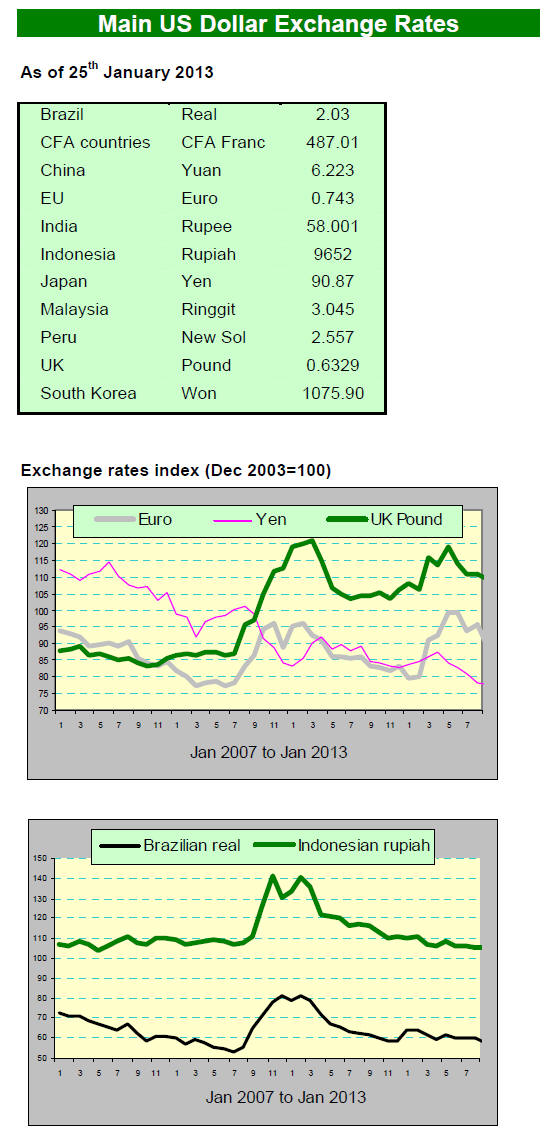2. GHANA
Implementation of VPA in Ghana
The Government of Ghana and the EU concluded negotiations on a Voluntary
Partnership Agreement (VPA) in September, 2008 and both parties signed the
world¡¯s first FLEGT VPA on November, 20th 2009.
Through implementing the VPA Ghana wood product manufacturers will be able
to satisfy demands in the market for proof that traded wood products are
legal.
Through the VPA Ghana also seeks to achieve the following:
governance reforms within the forestry sector
sustainable forest management
realisation of the full economic value of forests
viable forest sector which contributes to poverty alleviation
Piloting Legality Assurance System (LAS) completed
A key element of the VPA is the implementation of a Legality Assurance
System (LAS).
Between 2010 and 2011 the Government of Ghana piloted its LAS and the
associated Wood Tracking System (WTS). The results of this pilot have been
used to prepare for the national ¡®roll-out¡¯ of the WTS.
The Government of Ghana has contracted a Consortium ¨C Ata Marie Group to
further design and develop the WTS and assist in its national roll-out.
Interim arrangements in advance of compliance with VPA
Ghana is however, unable to meet the EUTR (EU Timber Regulation) effective
date of 3rd March, 2013.
As FLEGT Licensed wood products will not be available for some time the
Ghana Forestry Commission is working with stakeholders to put in place
interim arrangements to assure overseas buyers of the legality of the raw
materials used by manufacturers.
Programme launched to highlight VPA progress
The Ghanaian authorities have embarked on a programme to raise awareness and
inform stakeholders on progress in implementation of the VPA in Ghana.
This programme will be undertaken during February and March this year in
both Ghana and the EU.
The Ghanaian authorities also seek to exchange views with the Competent
Authorities in the EU in respect of the progress in implementation of the
VPA in Ghana.
Ghana has, through the VPA process, targeted the development of its domestic
market and has developed a public procurement policy to promote the use and
trade in legal timber in the domestic market.
Revenues from timber exports fell in September 2012
The latest available data shows that the total value of wood products
exported in September 2012 amounted to euro 7.54 million, an approximate 13%
decline from the euro 8.64 million earned in August 2012.
There was a corresponding 10% drop in the volume of exports from 21,235 cu.m
in August to 19,112 cu.m in September 2012.
The volume of air dried sawnwood exports between August and September 2012
increased by 3.5%, while export volumes for other products fell in the same
period.
Exports of plywood, dowels, mouldings, air dried boules and poles also fell
in September compared to levels in August.
The shares of the primary, secondary and tertiary product exports in
September were 3.7%, 93.3% and 3.0% respectively.
John Bitar & Co. Ltd was the leading exporter of plywood and kiln dried
sawnwood to markets in Nigeria, Burkina Faso and Benin. These markets
accounted for about 13% of total export earnings from wood products.
In terms of export markets by region, African markets accounted for 47.5%,
Asia/Far East 26.8%, Europe 16.1%, Middle East 5.0% and N. America 4.6%.
For timber export to the ECOWAS market, Nigeria¡¯s imports accounted for 55%
in terms of volume and 60% in terms of value.
New Minister for Lands and Natural Resources
The Ghanaian President His Excellency, John Dramani Maham, has nominated
Alhaji Inusah Fuseini as the new Minster for the Ministry of Lands and
Natural Resources. The nomination of the Mr. Fuseini was among the first
ministerial appointees presented to Parliament¡¯s Appointment Committee for
vetting and approval.
¡¡

¡¡
3. MALAYSIA
Production set to halt for Chinese New
Year holidays
As the Chinese New Year holidays approach the timber industries in Malaysia
are beginning to wind down production and prepare for a shut down from the
first week in February. Sawmills, especially in Peninsular Malaysia, will
shut for an extended break in early February.
Rubberwood furniture maker invests in plantations
The Malaysian Star newspaper reported (22/1/13) Celment Hii, director of the
country¡¯s largest rubberwood furniture manufacturer SYF Resources Bhd, as
saying the company does not expect to be seriously affected by the current
global economic slowdown and the narrowing of profit margins.
Hii said the company has diversified upstream through investment in rubber
plantations in order to secure its rubberwood raw material supply.
On a year-on-year basis, SYF¡¯s revenue for the last quarter of 2012 grew
from RM42.98mil in 2011 to RM58.07mil last year.
WTK to maintain cap on production until demand improves
The Star newspaper also reported on WTK Holdings Bhd, a major log supplier
based in Sibu, Sarawak. WTK produced 441,471 cu.m of logs in 2012 compared
to 530,864 cu.m in 2011. WTK produces plywood and other wood products. The
company says it will continue to cap production of logs until the demand
improves thus continuing the same reduced production policy adopted in early
2012.
The company cited the uncertainty in major markets and resulting reduced
consumption as the main reason for the decision to reduce output.
Sabah Forest department considers domestic legality assurance
Despite anticipation of the quiet period in industry over the New Year
holidays, the industry in Sabah has been busy working on legality issues.
The companies exporting to Europe are focussed on the impending coming into
force of the EUTR. Analysts report that the Sabah Forestry Department is
studying how the State should approach development of a Sabah timber
legality assurance scheme.
Data on timber exports from Sabah were released recently. Export levels for
the period January to November 2012 are shown below, (prices are FOB basis):
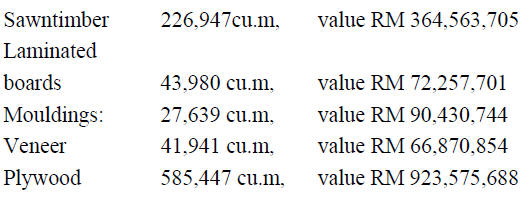
Sarawak industries prepare for Australian due
diligence
The industry in Sarawak is already experiencing quiet trading as overseas
buyers are well aware that production will soon come to a standstill and
company offices will close for the New Year holidays.
The Australian market is important for companies in Sarawak and the industry
is watching developments in the Australian Illegal Logging Prohibition Act
2012.
Some companies in Sarawak are already preparing to meet the due diligence
regulations so as not to disrupt timber exports to Australia.
Malaysian Furniture Fair strengthened by partnership with Muar Furniture
Association
In a press release the Malaysian International Furniture Fair (MIFF)
announced a strategic alliance with the Muar Furniture Association (MFA),
one of the most prominent furniture industry groups in Malaysia.
Beginning in 2013, MFA will participate exclusively in MIFF, Southeast
Asia¡¯s annual furniture trade show managed by UBM Asia, setting the stage
for the biggest ever MIFF since its inception in 1995.
This is the first ever commitment of its kind by the MFA. Manufacturers in
Muar account for 45% of Malaysian furniture exports from a base of about 500
manufacturers, including eight public-listed companies.
The participation of furniture manufacturers from Muar will further
strengthen MIFF as the single biggest platform for Malaysian furniture known
primarily for hardwood products.
MIFF 2013 will be held from March 5th to 9th 2013 at the Putra World Trade
Centre and Matrade Exhibition and Convention Centre in Kuala Lumpur.
Moves to cool real estate market
Over the past two years growth in the real estate sector in Malaysia has
been an important market for the timber industries in the country. However,
the growth witnessed over the past years is expected to slow in 2013 as the
government is determined to cool the sector.
The Malaysian government has introduced a 70 percent Loan-to-Value maximum
on loans to those buying a third property and is now basing the loan
assessment on net income rather than gross income
.
The government is also raising the property capital gains tax.
Analysts say that, while these changes will have an
impact on new investment in the Malaysia¡¯s property market, long-term
investors and people buying homes to occupy rather than for rent will
provide a measure of continued growth in the housing market.

Correction
In the previous ITTO report (17:1 15th Jan 2013) the statistics on exports
of plywood from Sarawak were incorrect. The correct data is: for the period
January to November 2012, Sarawak exported 2,402,120 cu.m of plywood, valued
at RM 3,634,972,141.
¡¡
4. INDONESIA
Jakarta businesses hit by deadly floods
Indonesia¡¯s capital, Jakarta, was brought to a standstill by flooding which
peaked on 17 January. Some 10 million people living and working in the city
were affected and 20 people are reported to have died in flood related
accidents.
The local media reports that more than 40,000 people were displaced and more
than 100,000 homes and businesses were under water.
Most of the timber industries located in Jakarta, Banten and West Java had
to postpone shipments during the 5 days of floods in Jakarta. Most exporters
managed to re-arrange export schedule but some are facing delayed shipment
penalties from buyers.
So far, there is no detailed information on the financial loses suffered by
timber industries located in Jakarta, Tangerang, bekasi, and Banten.
However, estimates put potential losses at around 1 trillion rupiah.
Analysts point out that some industries located in the flood hit pockets
such as the Pulogadung industrial area and Tangerang Banten probably
suffered financial losses because wood working machinery and raw materials
were submerged.
Jakarta is surrounded by mountains and 13 rivers flow through the city to
the Java Sea. The government has identified poor drainage in the catchment
areas of Bogor-Puncak-Cianjur as contributing to the flooding of the
Ciliwung river.
EU a major destination for processed wood products
The Indonesian Ministry of Forestry has reported that the volume of wood
products export during the past 12 months totalled 1.01million cu.m for
shipments to 94 countries, including EU member states.
The EU is a significant importer of Indonesian timber products.
While the volume of primary product exports to the EU was a modest 169.000
cu.m, or just 11% of the total export volume, exports of processed wood
products to the EU were worth US$ 210 million or 22% of the total export
value of all processed wood product exports.
Forestry and timber sectors could attract FDI
At the same time as the floods hit Jakarta the Government announced record
high levels of foreign investment (FDI) during 2012. Total investments of Rp
313.2 trillion (US$32.5 billion), exceeding the target of Rp 283.5 trillion,
were recorded.
Most of the investment was in the mining sector (17 percent of total FDI);
followed by the transportation and telecommunication sectors (11 percent)
and the pharmaceutical sector (11 percent).
Analysts point out that with the successful introduction of the domestic
timber legality assurance scheme, there is a good chance that investment in
the forestry and timber sectors will expand.
Indonesian SVLK satisfies EUTR
The Indonesian government has inaugurated a V-Legal/ FLEGT timber license
system to boost timber sales globally and especially to meet the
requirements of the EUTR.
The Indonesian government has said that when the EUTR enters into force in
March this year, Indonesian wood products shipped by exporters with the
domestic SVLK certificate will be deemed as satisfying the due diligence
requirements of the EUTR It is said that around 1,500 companies nationwide
have obtained SVLK certification.
Indonesia is the first Asian country to conclude negotiations of a Voluntary
partnership Agreement (VPA) and the Indonesia/EU VPA is expected to be
ratified in September this year.
EU importer expresses satisfaction with test shipment
The EU is a major destination for wood products from Indonesia and some EU
member states recently participated in a test shipment of verified legal
wood products from Indonesia.
The Netherlands Koninglijke Dekker Hout Group, which imports from Indonesia,
participated in the test shipment and expressed satisfaction on the results
of the test.
Indonesia looks forward to the early ratification of its VPA as this will
bring tangible benefits to Indonesian exporters and European importers
catering to demands of consumers in the EU.
Small companies offered help with SVLK certification
All wood product manufacturers in Indonesia are required to comply with the
domestic timber legality assurance system. This requires that they secure
third party verification.
The cost of securing the third party verification is a serious issue for
small scale industries and the handicraft makers. Until now these small
companies could not obtain financial or technical assistance to meet the new
requirements.
The Indonesian government has allocated an initial Rp 3 billion (US$312,000)
from the state budget to help subsidise small-scale producers in obtaining
SVLK certification.
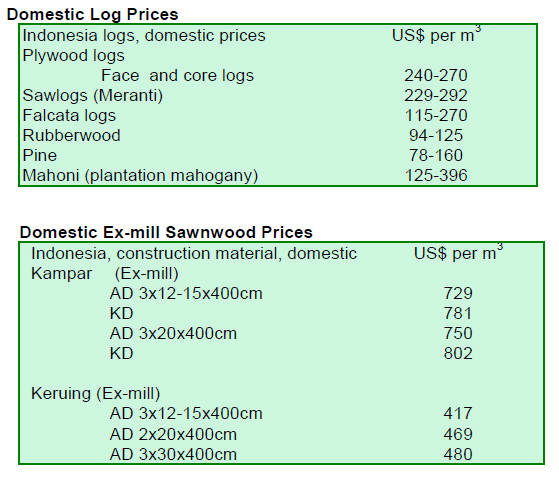
¡¡
5. MYANMAR
What is causing weak demand for teak in EU?
Analysts say that, despite the easing of economic sanctions, the demand for
teak in the EU, US and Japanese markets is low. Whilst the current economic
downturn in the EU and US may be partly responsible for the poor demand for
teak in these markets, other factors may be involved.
The number of companies in Thailand and Taiwan P.o.C manufacturing teak
products for export to Europe and the US has fallen dramatically over the
past few years.
Some traders suggest that teak seems to have lost the appeal it enjoyed in
the 1980¡¯s and 90¡¯s and that efforts are required to stimulate the markets.
The shrinking market for teak in Europe also seems to be linked to the
decline in the quality of teak being made available.
High quality teak, the grades preferred by Japan, US and EU are not now
readily available, reflecting the decline in the teak forests, say analysts.
The teak forests in central Myanmar have been harvested over and over again
and now yield only small quantities of high quality logs.
China and India major markets for teak
In recent years the log grades available have been mainly SG-4 and lower.
European buyers tended to purchase mainly higher grade 4th Quality logs but
the scarcity of higher grades has meant European buyers had to accept lower
grades such as SG-4.
Lower grades such as SG-7 and SG-8 are available in large quantities and
these grades are acceptable in the Indian market, especially now as the
Indian rupee has fallen against major currencies.
It is estimated that 80% of Myanmar¡¯s teak log exports go to India. It is
not possible to gauge the exact volume exported to China as only a small
quantity is shipped out by sea to China and is thus carefully documented.
Most teak for the Chinese timber industry is transported overland and
documentation of this trade is a major problem.
Undecided on investment in processing capacity
While many longstanding and experienced exporters and traders are
considering investing in wood processing industries in Myanmar in face of
the proposed log export ban, it is reported that some still believe that the
decision on the ban is reversible.
Plan needed to address forest degradation
The main issue confronting the forest authorities in Myanmar today, say
analysts, is not a total or a partial log ban but how to ensure harvests are
within the annual allowable cut to check forest degradation and
deforestation.
In order to develop appropriate polices it is vital that the state of the
forest is understood. There are conflicting reports on the forest cover
which must be addressed.
According to the Myanmar forestry authority the forest cover is around 47%
but according to the NGO community the forest cover is only around half of
that.
Verification of the actual forest cover is will take time and will involve a
considerable investment. Until such data is available there is a risk that
harvest levels will be set too high.
¡¡

¡¡
6.
INDIA
Timber imports through Kandla port
grow as industries in vicinity expand
Kandla Port registered double digit cargo growth during 2011-12. Strong
demand and increasing numbers of timber processing plants in the vicinity of
the port has resulted in higher imports of logs through the port.
In 2010-2011 log imports through Kandla port were 3.728 million cubic metres,
but in 2011-2012 the figure rose to 4.131 million cubic metres a rise of
10.8 %.
Currently there are 952 licensed wood working factories in and around Kandla
and analysts expected more plants to be established in the Kandla and Mundra
as the area is serviced by two very modern ports.
Over a 12 month period Kandla and Mundra ports handled some 992,000 cu.m of
Meranti logs mainly from Malaysia, 301,000 cu.m of Gurjan / Keruing logs
from Myanmar and Malaysia, some 1.4 mil. cu.m of Pine logs from New Zealand
and Europe and 455,000 cu.m of Teak logs.
The major supplies of teak, both natural forest and plantation teak were
Ecuador, Myanmar, Ghana, Costa Rica, Ivory Coast, Panama, Benin, Sudan,
Brazil, Tanzania, Togo, El-Salvador and Nigeria.
It is estimated that nearly 70% of all timber imported by India moved
through the ports of Kandla and Mundra. Analysts anticipate imports will
exceed 5mil. cu.m in the current fiscal year. New modern port facilities are
under consideration to service companies on the east coast of India.
Industry seeks reduction of State VAT on raw materials
The timber industries in the east have voiced concern over the high (15%)
value added tax (VAT) charged by the state government. The industry argues
that, as logs are the raw material input for industries the VAT should be
reduced to 4% to bring it in line with rates charged by many other states.
Reviving wood based industries in N.E. India
Central and State Governments have development plans for N.E. region of
India through a combination of private and public investment. Reviving the
development of the plywood industry in the region is under consideration.
Demand in India for plywood continues to rise and the ever widening gap
between supply and demand can only be met by imports.
The N.E. region of India was up until around 1966 a major centre for wood
based industries. At that time almost 80% of India¡¯s requirements for
plywood were being met from mills in that region.
To-day, mills in the N.E. provide to less than 10% of the plywood demand in
the country.
The N.E. has a climate suitable for plantations of the fast growing species
which are ideal for plywood manufacture. There is ample land available in
and around villages, adjacent to forest areas and close to tea-plantations
and deforested hills as well as along river banks.
Infrastructure in the region is adequate and there is a pool of experienced
technicians and skilled workers. Reviving the wood based industries in the
region would help reduce regional un-employment.
The agro-forestry developments in the northern Indian states of U.P.,
Punjab, Haryana and Uttaranchal are good examples of what can be achieved. A
revival of the plywood industry in N.E. India would deliver many benefits.
Cross border trade with Myanmar set to grow
Relations between India and Myanmar are improving which could lead to
expanded cross border trade. In the Border Trade Agreement of 1995
mechanisms for road transport of goods between India and Myanmar were
established bringing economic benefits to both countries.
Observers point out that the roads used for this cross border trade need to
be upgraded to make transportation of goods in both directions more
efficient. When this is done the timber industry will benefit and so will
other sectors for which the cross border trade is important.
The local prices for air dried Sawn timber per cubic foot, ex-saw mill
remain unchanged and are shown below:

Average prices realised at sales held in Government
Teak depots in Central India are shown below. The prices are per cubic foot
ex depot.
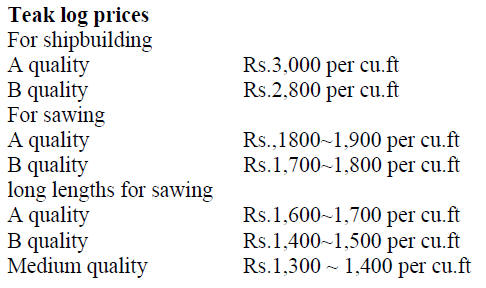

Myanmar Teak processed in India
The demand in India for Myanmar teak remains steady. Analysts in India say
that as the EU and US have improved relations with Myanmar the teak trade
between Myanmar and the west may expand which will mean Indian importers
will face increased competition.
Some Indian companies are already planning to shift processing capacity from
India to Myanmar in response to the proposed 2014 log export ban in Myanmar.
Prices for Myanmar teak are shown below:

Price variations are mainly due to differences in
lengths and diameter.
Despite the depreciation of the Indian rupee, teak sawnwood prices remain at
pre-depreciation levels as Indian buyers are reluctant to pay higher prices.
Some Indian manufacturers are replacing teak with durable non-teak hardwoods
such as Merbau
High quality plantation teak arriving from Sudan
Presently, out of all the sources of West African plantation teak, logs
coming from Benin are reportedly of the highest quality. The quality of
plantation teak from Sudan and shipped through Mombassa in Kenya is highly
regarded by Indian buyers and this is reflected in the log prices.
Current prices, C & F Indian ports, for Teak are shown below:
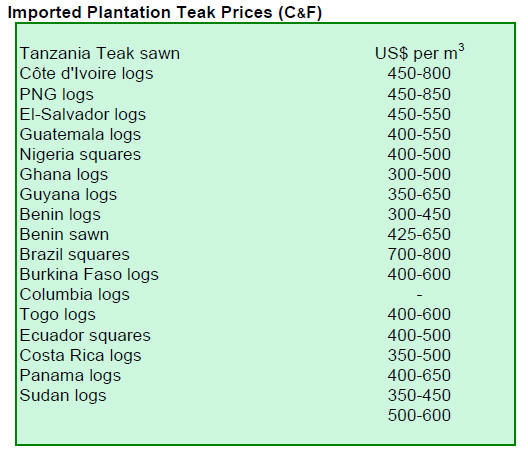
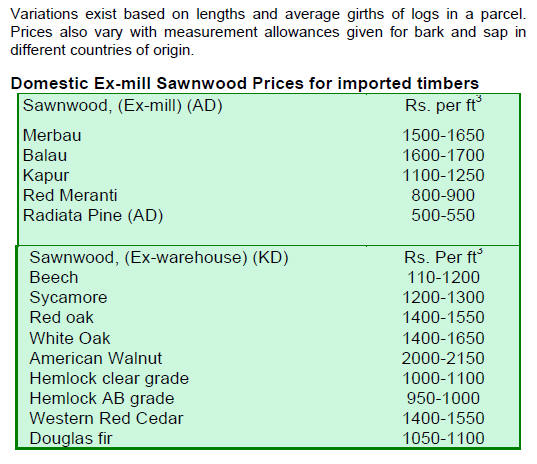
Indian plywood manufacturers seek protection
from low cost imports
The domestic plywood industry continues to face severe competition from
cheaper imports, mainly from China.
This is a matter of considerable concern in India as the small mills, which
number over 1000 and which support employment, are suffering the most.
A request from industry for an anti-dumping levy to be imposed on some
imports is being considered and support of Central Government is being
sought by the various plywood manufacturer¡¯s associations.
.
7.
BRAZIL
Inflation spikes in December but
yearly target achieved
According to the Brazilian Institute of Geography and Statistics (IBGE), the
inflation rate was higher than expected in December 2012.
The December Consumer Price Index (IPCA), at 0.79%, was the highest since
March 2011. The December 2012 figure was the highest rate for a month of
December since 2004.
Despite the spike in December inflation the Government reached its inflation
control target for 2012, stipulated at 4.5% with a variation of two
percentage points. In 2011, the inflation rate was 6.5%.
Further weakening of the Real against the US dollar
In 2012, the average real/US dollar exchange rate was BRL 1.95/USD. In 2011
the average was BRL 1.67/USD.
The average exchange rate in December 2012 came in at BRL 2.08/USD
indicating a slight easing of the Brazilian currency against the US dollar.
Reduction in interest rate possible in second quarter
The Monetary Policy Committee (Copom) of the Central Bank (BC), in its last
final meeting of 2012 and in the first meeting of 2013, decided to maintain
the prime interest rate (Selic) at 7.25% per year.
Many financial analysts are of the opinio that the Selic rate should be
maintained at its current level, at least during the first quarter of this
year and that a reduction to 7% could be considered for the second quarter
if the economy does not show signs of recovery.
Promoting investment in plantations not bonds
Investing in land and forest plantations is being promoted as an alternative
investment in Brazil. Investment companies claim that yields on investment
in Brazilian plantations in 2012 would have yielded better returns than on
gold or US saving bonds.
Several companies are offering plantation land as an alternative investment.
Investors can purchase plantation packages for as little as euro 6.200 to
500,000. The return on such an investment is only seen when the plantations
mature and are harvested.
Brazilian entrepreneurs are optimistic that demand for wood products in the
domestic and international markets will continue to grow.
The hosting of the Olympic Games and World Cup will involve considerable
investment in construction leading to increased demand for wood products say
analysts. Also, the Brazilian government is promoting building of more
housing for low income families which will increase demand for wood
products.
Demand for hardwood planting stock expected to rise
In 2012 the demand for seedlings of high value hardwood species for
plantations exceeded expectations. Projections for 2013 anticipate a
tripling of demand according to Tropical Flora Reflorestadora, a specialist
company providing planting stock.
Investment in the so-called ‘green economy?is now being actively promoted and
workshops have been organised by Tropical Flora to provide information on
the potential of this type of investment.
Currently, the hardwood species that have been planted include Guanandi (Calophyllum
brasiliense), African mahogany (Khaya ivorensis), Jequitib?Rosa (Cariniana
legalis), Teak (Tectona grandis ) and Cana fístula (Peltophorum dubium).
Forestry experts say that farmers could plant such high value hardwoods
alongside coffee, pupunha palm tree and other crops to generate higher
income.
Round up of December 2012 timber exports
In December 2012,the value of wood products exports (except pulp and paper)
fell 5.9% compared to values in December 2011, from US$ 218.6 million to US$
205.7 million.
Pine sawnwood exports declined 30.4% in value in December 2012 compared to
December 2011, from US$ 14.8 million to US$ 10.3 million. In terms of
volume, exports dropped from 66,100 cu.m to 46,000 cu.m over the period.
Exports of tropical sawnwood fell 26% in volume, from 44,700 cu.m in 2011 to
33,100 cu.m in December 2012 compared to December 2011, (from US$ 24.7
million to US$ 16.4 million).
Pine plywood exports rose 21% in value in December 2012 compared to December
2011, from US$ 26 million to US$ 31.5 million. The volume increased was just
over 19% in December, from 71,600 cu.m to 85,500 cu.m.
Exports of tropical plywood fell from 5,200 cu.m in December 2011 to 5,100
cu.m in December 2012, an approximate 2% decline.
A much higher rate of decline was observed in the value of tropical plywood
exports in December where a 22% fall was registered, (US$ 3.6 million to US$
2.8 million).
Brazilian exports of wooden furniture dropped from US$ 44.3 million in
December 2011 to US$ 41.1 million in December 2012, a 7% decline.
"Orchestra Brazil"diversifies furniture export markets
A project called “Orchestra Brazil?is promoting diversification of export
markets. This project is a partnership between Sindmóveis (Association of
Furniture Industries of Bento Gonçalves) and Apex-Brazil (Brazilian Trade and
Investment Promotion Agency).
The aim of “Orchestra Brazil?is to improve the competitiveness of Brazilian
furniture exporters . This is being achieved through combining the expertise
from manufacturers, suppliers, technologists and designers to the furniture
sector. The target markets for this initiative are Peru, Paraguay, Uruguay
and Argentina.
From 2005 ?2011 the annual import growth of companies associated with the “Orchestra
Brazil?initiative in the four target markets was over 15% in Peru; 26% in
Paraguay; 13% in Uruguay and 15% in Argentina. Research has concluded that
this project was highly regarded in Peru, Paraguay and Uruguay.
Despite the declining imports by Argentina of furniture from Brazil, the
result of barriers affecting bilateral trade say analysts, the country was
the second largest importer of furniture from companies associated with the
"Orchestra Brazil" initiative.
Brazilian sawmilling sector anticipates positive growth
The Brazilian sawnwood industry is forecasting positive growth in 2013 in
anticipation of increased demand resulting from construction of facilities
for the World Cup (2014) and the Olympic Games (2016). A further boost to
demand will come from the government’s housing programme "My House My Life (Minha
Casa Minha Vida)".
In other encouraging news the Brazilian Association of Mechanically
Processed Timber Industries (ABIMCI) has indicated that the federal
government intends to reduce payroll taxes for the sawnwood sector in 2013.
The Ministry of Development, Industry and Foreign Trade (MDIC) is said to be
considering eliminating the tax on Industrialized Products (IPI) for plywood
and also the 8% tax charged when the Brazilian forest products are exported
to the US market.

¡¡
8. PERU
Civil society calls for greater
dynamism in forestry reform
A group of civil society organizations has petitioned the head of the
Ministry of Agriculture (Minag), Milton Von Hesse, for a more dynamic reform
of the forest and wildlife sectors to, as they say, "give it competitiveness
and inclusion ".
The petition mentions the status and progress in improving the policy and
institutional framework of forestry management in the country and
specifically recommends:
the development of a new participatory policy for forestry and wildlife;
the design and implementation of improved institutional arrangement and
a revised Forest Act and Wildlife Act
The petition directed at the Ministry of Agriculture says "We urge your
office to strengthen the team of the Forestry and Wildlife (DGFFS),
providing dedicated staff necessary for the process, the necessary budget
for implementation of activities and the political and institutional support
of all Ministries¡¨.
Regarding the proposed draft National Forestry Policy and Wildlife (PNFFS),
submitted in December 2012, the organizations asked to expand to 120 days
the period for receiving input from the public¡¨.
The group further asked for greater transparency in progress with
development of regulations being developed by the National Forestry and
Wildlife Agency (SERFOR).
The petition to the Ministry was signed by organizations such as the
Peruvian Society for Environmental Law (SPDA), Law Environment and Natural
Resources (DAR), Peruvian Society for Ecological Development (SPDE),
Proetica, Association for the Conservation of the Amazon Basin (ACCA),
Center Indigenous Cultures of Peru (Chirapaq), the Centre for Environmental
Sustainability Universidad Peruana Cayetano Heredia (CSA-UPCH), amongst
others.
Forestry Training Centre in Peru
The Tropical Forest Foundation has launched a fundraising campaign to secure
funds to accelerate the development of a training and education centre in
Peru.
This centre would focus on how to balance sustainable forest management,
demand for wood products, the ecological integrity of the forests and the
economic welfare of local communities.
This training centre would, if funds are forthcoming be built in the Amazon
region of Madre de Dios an area which has about 350,000 hectares of
certified forest.
¡¡
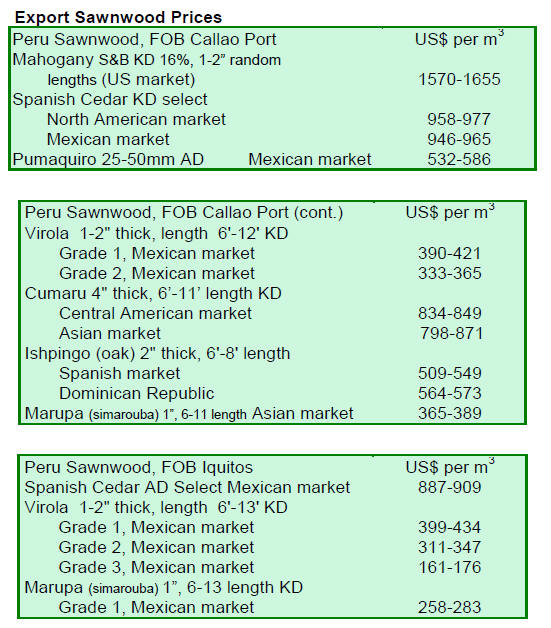

¡¡
9.
GUYANA
Slow start to year for log exporters
A slowing of log exports in the early part of the month was observed, the
cause of which say analysts, was the extended holidays in the main western
markets. However, some Mora log contracts were shipped and prices were
reported as fair for all categories.
Shipments of Undressed Greenheart sawnwood were concluded during the month
but prices weakened for select grade.
On the other hand prices increases for Sound quality were recorded and
prices rose from US$ 700 to US$ 721 per cubic metre. Prices for Merchantable
quality were reported as only fair.
More species exported to the EU
There were no exports of Undressed Purpleheart sawnwood early in the month.
Undressed Mora sawnwood prices held steady, unchanged from December 2012.
Europe is the main market for Undressed Mora sawnwood. Some of Guyana¡¯s
lesser used species such as Burada, Darina, Fukadi and Kautaballi made their
way to the European market and prices were reportedly satisfactory.
Dressed Purpleheart sawnwood prices were maintained at around US$ 1,080 per
cubic metre. Guyana¡¯s Washiba (Ipe) sawnwood price remains very attractive
to exporters who now earn a maximum price of US$ 2,300 per cubic metre,
mainly form buyers for the North America market.
Suriname, a growing market for plywood
Prices for Guyana plywood BB/CC category held steady at around US$ 584 per
cubic metre. Suriname is now a significant importer of plywood from Guyana.
The market for Splitwood (shingles) was reported as good during January and
prices were at US$ 909 per cubic metre in the markets of the Caribbean.
Guyana revises export tax schedules
After a thorough consultative process the Government of Guyana published
amendments to its policy on the export of logs and squares. The policy
document sets out a schedule of increases in export taxes for specific
species and products.
The new export duty rates has one schedule for logs and another for squares
with dimensions of 20.3 cm x 20.3 cm and above.
The rate of export duty in Schedule A (logs) will be 15% in the first year,
17% in year two and 20% in the final year of the amended policy schedule.
The export duty rates applied to squares (Schedule B) will be 12% in the
first year, 15% in year two and 17% in the final year. At the end of the
three year period a decision will be made for future rates.
Exports of logs and squares of species not identified in either Schedule A
or B will attract a 2% across the board flat rate of export duty.
The government policy notes that special consideration will be given to
local companies or entities exporting squares (products with dimensions of
20.3 cm x 20.3 cm and above) which are to be used in the sizes exported for
engineering end uses and applications.
The latest policy document extends the total restriction on the export of
Crabwood (Andiroba) and Locust (Jatoba) logs.
This policy document is considered a significant way to further improve the
performance of the sector through encouraging adding more value to forest
products so as to contribute further to the development of Guyana forest
sector.
See below for schedules for round logs and squares.
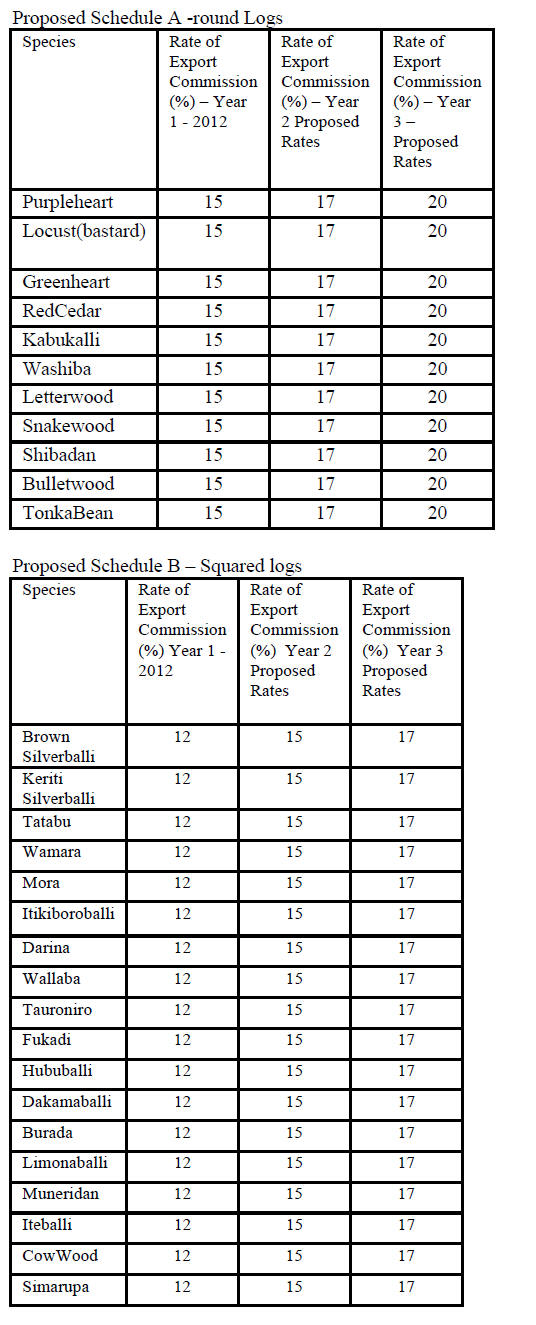
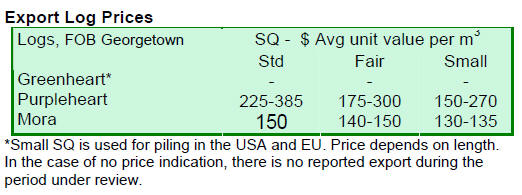
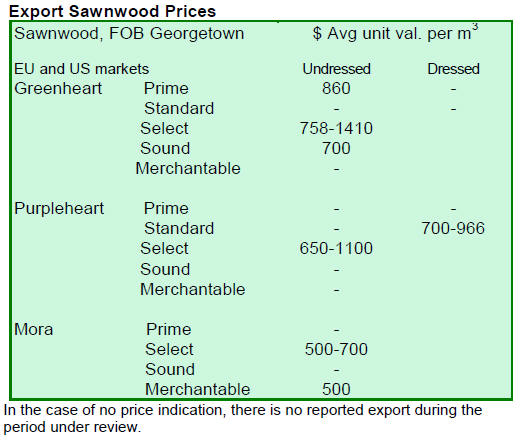
¡¡
